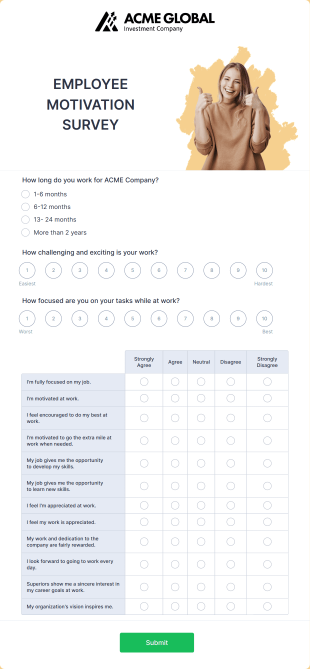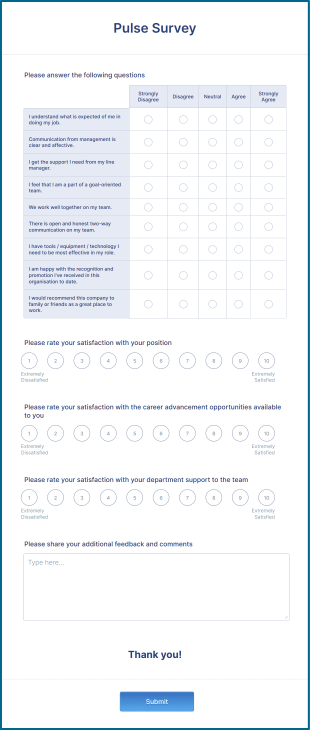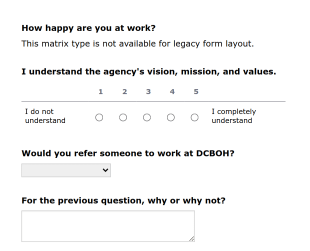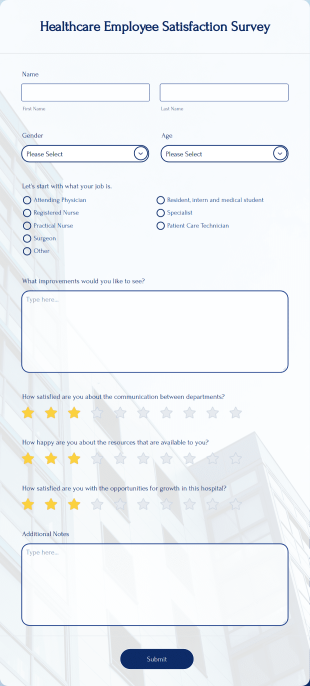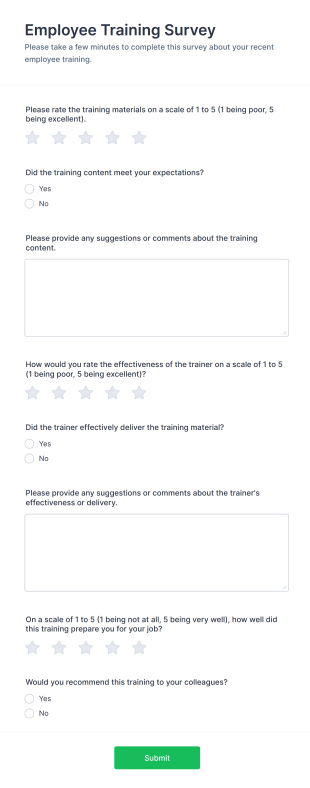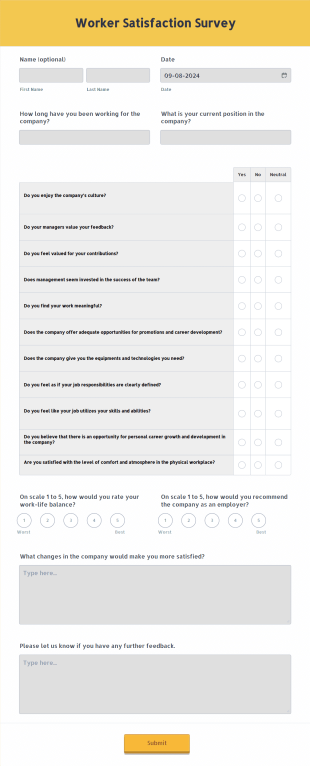Employee Satisfaction Survey FAQs
1) What is an employee satisfaction survey?
Organizations use employee satisfaction surveys to gauge how content their employees are at work. The purpose of the survey is to understand what employees like about their jobs and what they think needs improvement. That information can help the organization improve its overall work environment while retaining top talent.
Employee satisfaction surveys typically include questions about job satisfaction, work environment, workplace culture, career development opportunities, and other topics related to the employee experience. By understanding what’s making employees feel satisfied or dissatisfied at work, employers can develop a plan to make necessary adjustments and show their employees how much the company values them.
2) Why is employee satisfaction important?
Employee satisfaction is important because happy employees tend to be more productive, engaged, and motivated, contributing to better business outcomes. Employers benefit from the increased loyalty and commitment of employees who feel valued and appreciated. Additionally, satisfied employees are also less likely to do something unethical or cause workplace conflict that can negatively impact the business.
You can use surveys to measure employee engagement, morale, and commitment. The data you collect from employee satisfaction surveys can give you valuable insights about where you can make changes to create a healthier work environment for all employees. This kind of feedback is crucial for organizations looking to foster positive relationships between staff and management and to ensure employees are getting the support they need to be productive and successful.
3) How do I create an employee satisfaction survey?
Before creating an employee satisfaction survey, first identify your goals. For example, you might want to improve company culture, increase motivation, or emulate the performance of a high-performing team within your organization. Once you understand your goals, you can begin creating an effective survey by following these steps:
- Develop questions that address specific concerns. Tailor the questions specifically to assess employee satisfaction in a meaningful way, such as asking about job satisfaction, overall morale, and commitment to the company.
- Keep it short and simple. If you want employees to respond to your survey, make sure it’s brief and to the point. Too many questions can make the survey seem overwhelming or intimidating for participants, so aim for 10–15 questions that are easy to understand.
- Offer an incentive. Offering a small reward, such as gift cards or extra vacation time, can help boost response rates and make employees feel appreciated for giving their input.
- Keep it anonymous. Letting employees know that their responses are confidential will encourage honest feedback and increase the accuracy of your results.
- Follow up with employees. Once your employees complete the survey, be sure to follow up with future surveys to monitor whether your efforts are improving employee sentiment. This will help you track the effectiveness of your efforts and show employees you’re committed to improvement.
The purpose and focus of your survey will affect when you need to send it out. If you’re looking for feedback on an event or change that you recently instituted, it’s helpful to send out your survey soon after so the event is fresh in your staff’s minds. More general surveys give you more scheduling flexibility, but try to send them during times when things are quieter for staff, so they have more time to dedicate to the survey. Also, try to send surveys during the week. Avoid Fridays.
Using a survey template can save you time and make the process of creating the survey much less overwhelming. With Jotform’s survey template, you can customize everything from the questions themselves and the question types to the colors and branding. Save your survey so you can edit it for future use, making it much easier to send follow-up surveys.
You’ll also need to determine how to best distribute the survey. It may be best to email staff a link to the survey, giving them easy access to it so they can fill it out when they have time. In addition, you can embed the survey on the staff-facing portion of your website, so even if staff misplace the email, they can still access the survey.
You may also want to add a deadline for completing the survey. Having a deadline helps create a sense of urgency, motivating staff to complete the survey. A deadline also ensures that the feedback you receive all refers to the same time period, so you can send out follow-up surveys without causing confusion.
Don’t forget to generate plenty of conversation about the survey. If you’re just starting to survey staff, then it’s helpful to introduce the idea during a staff meeting when you can explain the motivation behind your efforts. Discuss how you’ll review the feedback they provide, and disclose how you’ll go about creating improvements based on the feedback they’ve given.
Remind staff about the survey deadlines through emails and in additional meetings, and ask supervisors to take an active stance in discussing the survey with their teams. All of these efforts can help maximize the survey completion rate so you have the most detailed and accurate results possible.
4) What questions should I include in an employee satisfaction survey?
An employee satisfaction survey gives you a chance to ask about key elements of the workplace and the employee experience:
- How satisfied are you with your job overall? Knowing how satisfied your employees are can help you identify potential problems and address them quickly, leading to better morale and improved productivity. Additionally, it gives your team an opportunity to provide feedback on existing processes, suggest improvements that you could make in the future, and ensure everyone feels heard and valued.
- Do you feel valued at work? The responses to this question allow employers to better understand the well-being of their staff and the overall morale in the workplace. When employees feel valued, they’re more likely to be motivated and engaged with their work and to go above and beyond for the company.
- Do you have the resources you need to perform your job well? Asking employees this question establishes a dialogue between the employer and employee about the current state of resources. It also allows employers to assess whether there are adequate tools, equipment, and materials for employees to efficiently carry out their duties — another way to boost morale and work performance.
- Does your job cause you stress or anxiety? Stress and anxiety can have detrimental effects on mental health and job performance, leading to lower productivity, increased absenteeism, decreased motivation, and even burnout. As such, it’s important to ensure that employees feel supported in their roles so they can continue performing at their best.
- Is management making sufficient efforts to solicit opinions and feedback from colleagues? Increased collaboration among team members can lead to improved productivity and better problem-solving. Furthermore, when everyone has a chance to contribute their input, it helps create a feeling of ownership among team members, which leads to greater employee commitment and engagement. Communication is key, so it’s important to ensure everyone on the team has a chance to speak up and be heard.
- How motivated do you feel at work? Collecting this information gives employers insight into potential problems that sap motivation and drive, enabling them to craft an environment that’s more conducive to higher productivity and worker engagement. It also helps employers foster collaboration rather than toxic competition by identifying negative management tactics.
- How effectively do you feel the company is using your skills and abilities? This question can help employers identify potential improvements that can maximize their employees’ potential. It allows employees to hone their most valuable skills and take on more challenging tasks, while making them feel supported and valued in the workplace.
- How well do you feel your manager and colleagues support you? The responses to this question can help you identify underlying issues with team dynamics and management competency. You can also use employee feedback to improve morale, strengthen communication, create better working relationships, and foster a sense of inclusion in the workplace. All of these aspects work together to create an environment in which employees are more likely to succeed, stay motivated, and contribute positively to their team’s success.
- How satisfied are you with your benefits and compensation? Benefits and compensation data help you determine if employees feel undervalued or under-compensated, which can hinder job satisfaction and performance. Moreover, employee feedback provides insights into what benefits or wages you may need to offer to remain competitive in the marketplace — keeping the organization up to date in the labor market.
You can structure your survey so that many of the questions are multiple choice or allow respondents to agree or disagree on a scale. It’s also important to include some open-ended questions that allow team members to provide specific, detailed feedback and suggestions.
5) What are the five elements of employee satisfaction?
The Chopra Center reviewed multiple research studies and surveys to identify the five elements of job satisfaction. Organizations like the Journal of Healthcare Management, Gallup, The Conference Board, and the Society for Human Resource Management performed these studies.
The research, summarized by Noah Shaw with Pollack Peacebuilding Systems , noted that while extrinsic factors like salary are important, intrinsic factors had the greatest impact on an employee’s satisfaction. For example, one survey showed that professional growth opportunities and personal values that aligned with the company were more valuable than pay when it came to overall job satisfaction.
According to the research, five factors are key to employee satisfaction in the workplace:
- Engagement: Employees who are engaged in their work feel more connected to and invested in it, which can lead to increased satisfaction.
- Respect: Employees need to feel respected, and receiving praise and appreciation for their work helps them feel valued.
- Fair compensation: Compensating employees fairly for their work contributes to the feelings of appreciation and respect noted above. Fair compensation can affect an employee’s overall life satisfaction too.
- Motivation: Motivation plays a role in an employee’s engagement at work. Motivated employees are more likely to be focused on and invested in their jobs, and they’re often happier as a result.
- Life satisfaction: Employees who are satisfied with their lives are more likely to be satisfied with their work as well.
6) Do employee satisfaction surveys work?
Employee satisfaction surveys can be very helpful, valuable tools, but only if you use them strategically and design them well.
For a survey to be effective, it needs to be relevant to your staff. Survey templates are a great place to start, but you may find that you need to customize the questions so they apply to your employees’ experiences.
It’s also important to design a survey in a way that increases the likelihood your employees will complete it. Long surveys can be cumbersome and time-consuming, and employees may get tired or frustrated and stop filling out the survey partway through.
Conducting anonymous surveys is a must if you want honest feedback, particularly about any negative aspects in the workplace. Not only do you need to design the survey so that it’s anonymous, but you also need to highlight that fact repeatedly when you send the survey to staff.
You’ll also need to put thought into your survey’s timing. Sending too many surveys too often can lead to survey fatigue, and staff may not take the time to complete them. But only surveying your staff once a year can be a mistake, too, since employee satisfaction can fluctuate over time. A happy balance may be to send a quarterly survey or a shorter monthly survey if you need more frequent data.
You may need to incentivize your staff to complete the survey. Giveaways to staff who completed the survey can be a popular option. It can also be helpful to explain why you’re asking staff to complete the survey. Explaining that you want to be sure everyone’s satisfied and that you’re looking for ways to better support your team can help everyone take it more seriously.
Finally, for your employee satisfaction survey to be effective, you need to take the time to review the results and take action based on the feedback you’ve received. It can be helpful to schedule a time to review the results with your leadership team. Consider taking one or more ideas presented in the survey and implementing them in your business each month or quarter. You can gather feedback on how well those ideas are helping in your next survey.
7) What is the purpose of employee surveys?
Employee surveys help you gather timely information about your staff. These surveys can help you learn about the general morale in the workplace, how employees have responded to recent changes, how happy your team is, and most importantly, what you can do better to keep your employees happy.
These surveys are most helpful when you use them periodically, since staff satisfaction can change significantly over time. Some businesses use them quarterly or even monthly, and, in doing so, they gain information they can use to improve staff satisfaction.
Improving employee satisfaction leads to numerous benefits. Happier employees tend to be more invested in their work and more dedicated to their jobs. They are often more productive, and in customer-facing positions, they positively represent your business, which can lead to more customers and increased revenue.
Focusing on employee satisfaction can also improve staff retention. While better retention is always valuable, it’s more important now than ever before. Countless businesses are facing staffing challenges, and scrambling to cover staff vacancies can strain your existing team, leading to decreased satisfaction.
By maximizing staff retention rates, you can keep your best staff — those who know your company well and do the best work. Hiring and training a new employee is very time-consuming and expensive, and frequent staff turnover can quickly eat into your profits. By working to retain your staff, you can ensure that you have talented people running and representing your business, which increases the quality of service that you’re able to provide to your customers and clients.
8) Who can use an employee satisfaction survey?
Employee satisfaction surveys are beneficial tools for any organization that employs people. They provide valuable insights into how employees feel about their jobs and working environment, allowing employers to identify where they need to make adjustments or what they’re doing well.
Surveys also give employees a platform to express their opinions and feelings in a safe and anonymous setting, creating an atmosphere of trust and understanding between employers and employees. Typically, business owners, C-level employees, and management teams are keenly interested in employee morale.
9) Can organizations use an employee satisfaction survey to identify the root causes of employee dissatisfaction?
Yes. You can identify the root causes of employee dissatisfaction by asking questions about specific aspects of the work environment, such as communication, leadership, and workload. By analyzing survey responses and organizing different types of feedback into categories like job type, employers can pinpoint specific areas where improvements are needed.
In addition, employers can use the survey results to develop targeted solutions that address the issues identified in the survey. However, bear in mind that simply implementing solutions based on employee feedback doesn’t guarantee increased employee satisfaction — it’s essential to give your employees a voice when creating and implementing those solutions. That way, your employees feel heard and are more likely to support the proposed solutions.
10) Can organizations use an employee satisfaction survey to assess the effectiveness of HR policies and programs?
Yes. It’s an excellent way for employers to get feedback from their employees on job satisfaction, the benefits they receive, their work environment, and so on. Additionally, it can provide employers with the opportunity to recognize the successes of their current HR practices and reward employees who excel in their roles.
11) Can organizations conduct employee satisfaction surveys on a regular basis?
Yes. You can conduct employee satisfaction surveys annually or semiannually to track changes and improvements over time. Regular satisfaction surveys provide employers with feedback to ensure the workplace meets employees’ needs and provides them with an optimal work experience. Tracking employee satisfaction over time is also essential for measuring the performance of any HR programs you’ve designed to improve an aspect of the employee experience.
12) What are the best practices for conducting employee satisfaction surveys?
By following best practices, organizations can gather reliable and meaningful data to understand how employees feel about their work environment:
- Take measures to guarantee anonymity and confidentiality so employees feel safe and secure in expressing their honest opinions.
- Use clear and concise language when crafting the survey questions so all respondents understand what you’re asking of them.
- Avoid asking leading or biased questions that could influence the results.
- Target your survey to the right employees to control the scope and cost of the initiative.
- Use a variety of question types to gather diverse responses, ranging from questions with simple yes or no answers to questions that allow employees to express themselves.
- Leverage pulse surveys to gather feedback quickly and frequently. These surveys are especially useful for follow-up questions.
13) What are the 6 scales for measuring job satisfaction?
There are many tools available to measure job satisfaction. Consider which is best for your business and for getting the most useful information.
Job in General Scale
The Job in General Scale (JIG) is a questionnaire that organizations frequently use. It pairs with the Job Descriptive Index (JDI). When administering the JIG, ask your employees to identify how well a statement applies to their career. For example, you might state, “My daily work is stimulating.” Employees can choose from options like Yes, No, and Undecided. The JIG focuses on an employee’s satisfaction with the overall job.
Job Descriptive Index
Similar to the JIG, the JDI also asks employees to identify how well a statement applies to their career. Employees will need to think about and identify their satisfaction with specific elements of their job, like coworkers, the work, pay, opportunities for promotion, and supervision.
Gallup Workplace Audit
The Gallup Workplace Audit measures multiple elements of the workplace and includes work satisfaction elements. Employees respond to the questions using a scale of 1–5. The audit includes 13 items and is available for purchase from The Gallup Organization.
Job Diagnostic Survey
The Job Diagnostic Survey measures an employee’s satisfaction within five work elements, including job security, pay, colleagues, supervision, and growth opportunities. Employees will need to identify their level of satisfaction with each element. This is a shorter survey and takes about 30 minutes to administer.
Andrews and Withey Job Satisfaction Questionnaire
Developed in 1976, the Andrews and Withey Job Satisfaction Questionnaire consists of almost 100 questions. It tends to yield good results, but it’s such a long survey that it isn’t practical to administer in most workplaces.
Employee Satisfaction (ESAT) score
An ESAT score is an important metric companies use to measure the overall level of job satisfaction among their staff. It’s usually calculated on a scale. If you’re rating from 1–10, with 10 being the most desirable outcome, a higher ESAT score would indicate that employees are more content, engaged, and motivated in their roles and the workplace, which, in turn, can help improve morale, productivity, and job satisfaction overall. Companies that monitor and focus on increasing their ESAT score are likely to experience better performance outcomes in the long run.
You can gather ESAT scores through surveys or interviews conducted with employees. These tools provide a platform for staff members to express their opinions and voice their concerns, allowing companies to better understand their staff’s overall level of satisfaction. Companies can also use the data these surveys gather to inform decisions about specific improvements or changes to make in order to increase employee satisfaction.
Keep in mind that while these scales are available in ready-to-use formats, you may have better success designing your own employee satisfaction survey. By designing a custom survey, you can add elements that are relevant to recent workplace events or initiatives. You can also gather the specific types of feedback that you most need, and you can keep the survey applicable to your employees’ unique experiences.
In addition, you could conduct focus groups and in-depth interviews, which allow for a deeper exploration of employees’ attitudes toward their jobs, the organization, and the work environment.
14) Can there be negative consequences to performing employee satisfaction surveys?
Yes, there are potential negative consequences to performing an employee satisfaction survey. If an employer doesn’t conduct a survey in a reliable and trustworthy manner, it could result in mistrust between employees and employers as well as fear of repercussions or judgment. The survey results may also be skewed if the questions are leading or biased, which can lead to inaccurate data.
15) Why is it important to develop a communication plan for your employee satisfaction survey?
A communication plan helps ensure that all stakeholders clearly understand the survey and its goals. It also serves as a tool to guide and measure progress in surveying employees. The communication plan should include clear objectives, a timeline, and strategies for involving key departments and individuals in the process.
The plan should include strategies for collecting and analyzing feedback as well as how you’ll share the insights with the team. Communicating the results and the company response in a timely manner ensures you’ll take action while employees are most likely to support your initiatives.








